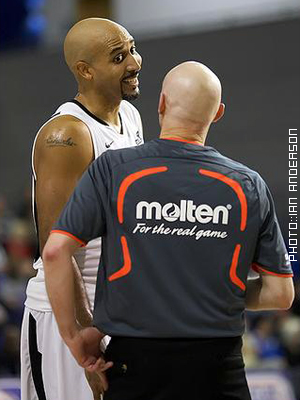Refereeing Masterclass pt 2
- Comments: None
PLAY SITUATIONS - INTERPRETING CONTACT


SCREENING
The purpose of screening is to prevent an opponent from reaching a desired position on the court. For screening to be legal the player setting the screen must be STATIONARY with both feet on the floor.
 Understand the purpose of screening. Not all contact with a screen is illegal. If the screen is set legally then the contact, irrespective of the level, should be considered incidental. Contact which occurs because the player setting the screen is moving is illegal. CONTACT must occur for an illegal screen to exist.
Understand the purpose of screening. Not all contact with a screen is illegal. If the screen is set legally then the contact, irrespective of the level, should be considered incidental. Contact which occurs because the player setting the screen is moving is illegal. CONTACT must occur for an illegal screen to exist.
If the screen is set within the field of vision (OPEN) of a stationary opponent, the screener may stand as close as possible to his opponent without causing contact, either to the FRONT or SIDE.
If the screen is set outside the field of vision (BLIND) of a stationary opponent, the screener must take a position which allows his opponent to make a normal movement (1 step) to avoid the contact.
If the opponent of the screener is moving (MOTION), the screen must be set with regard to elements of time and distance. The screener must allow sufficient space (1 – 2 normal steps) for the opponent to avoid contact by stopping or changing direction.
The player setting the screen is not allowed to extend any body parts (knees, legs, elbows, forearms, buttocks etc.) outside his normal cylinder in order to ensure that the screen is effective, especially in the case of any misjudgement by the screener. It is essential that officials see the play from start to finish.
Be aware of the actions of the player being screened. He is not permitted to push his way through the screen or dislodge the screen, if it has been legally set, by illegal use of the hand(s), arm(s), hip(s) or shoulder(s).
Be aware of actions related to the use of “Pick and Roll” plays:
Understand and be able to recognise pick and roll plays during a game. Be ready to interpret the legal or illegal actions of both offensive and defensive players when the offensive team is running the “pick and roll” play.
OFFENSIVE players:
Watch for the illegal use of hands just after the impact of the screen and before the roll to the basket.
Watch for illegal use of the body, hips and legs by the screener, taking a step into the defensive player as his team-mate is clearing the area.
Watch for illegal contact by the screener when he pushes the defender before he starts his roll to the basket.

Be careful not to interpret such illegal actions as incidental contact, because such actions put the defensive player at a distinct disadvantage.
DEFENSIVE players:
Watch for illegal hand and/or body checking which restricts the path of the offensive player who is attempting to set the screen.
Watch for illegal contact with an opponent designed to interrupt the rhythm of the play, by pushing the opponent into his own team-mate.
Watch for illegal use of the hand(s) at the point of the screen.
Watch for defenders pushing out with knee(s)/forearm(s) when posting up away from the basket or defending 3 point goal attempts
Be careful not to interpret such illegal actions as incidental contact, because such actions put the offensive player at a distinct disadvantage.
Incidental body contact is a part of the game, but the deliberate use of the hand(s), arm(s) and body to gain an advantage is not part of the game.
CHARGE – BLOCK
75% of all charge-block calls will be challenged by the team penalised. The official must know what a legal guarding position is and what are the rights of the player with and without the ball.
A legal guarding position requires the defender to be on the spot first, with two feet on the floor, upright, stationary and facing his opponent. Having established a legal guarding position the defender is allowed to move laterally or backwards in order to maintain his position in front of a moving opponent. He is NOT allowed to step FORWARDS to the player/ball.
It is important that referees watch the whole play from beginning to end with specific reference to the actions of the defensive player prior to any contact that may occur. Be alert to ‘flopping’ by players.
 Note the point of contact. If a legal guarding position has been achieved, contact by the offensive player should be on the front of the torso, between the shoulders –chest- of the defensive player. If contact is on the shoulder, hip or leg of the defender then responsibility lies with the defender.
Note the point of contact. If a legal guarding position has been achieved, contact by the offensive player should be on the front of the torso, between the shoulders –chest- of the defensive player. If contact is on the shoulder, hip or leg of the defender then responsibility lies with the defender.
Once the offensive player has succeeded in establishing his head and shoulders past the torso of his opponent (usually by speed of movement) responsibility for contact lies with the defensive player.
Ensure that CONTACT has actually occurred and that you are not influenced by the actions of defensive players “flopping” or offensive players making a “theatrical reaction”. It is essential that officials are in an excellent position in order to have a clear view of any contact.
Protect the rights of the airborne player. If the offensive player has left the floor BEFORE the defensive player establishes his position, however late, he has the right to land in a pre-determined spot on the floor. Timing and movement are the keys to this play.
Referees should be aware of charge-block situations when:
A transition or fast break occurs.
An offensive player beats his defender in a one v one play.
Defenders switch positions to give defensive help.
Double team pressing defense occurs.
“Pass and crash” situations occur on a drive to the middle of the key. (The dribbler passes off and crashes into a stationary defender)
‘Blind’ block on high pass near to the basket or during a ‘press
UNSPORTSMANLIKE FOULS
Any illegal action that is not a legitimate attempt to play the ball or an opponent should be considered as unsportsmanlike.
Wrapping the arms around an opponent, grabbing a player with one or both hands, grabbing the shirt or shorts of an opponent are all unsportsmanlike actions. Grabbing a player’s arm or body whilst initially trying to play the ball is also an illegal action.
Grabbing, holding or pushing a player AWAY from the ball is an unsportsmanlike foul by rule.
Committing clear fouls in order to prevent an opponent close to the basket from scoring 2 points is in many cases an unsportsmanlike foul.
Excessive contact, undue roughness against an opponent (especially airborne), even when trying to play the ball is considered an unsportsmanlike foul by rule.
All these situations must be interpreted within the spirit and intent of the unsportsmanlike foul rule. What is an unsportsmanlike foul must apply at any time of the game, in the first minute and the last minute. Do not be influenced by the intensity, score and time remaining in the game.
PLAYER and COACH BEHAVIOUR
The proper conduct of the game demands full and loyal cooperation of the members of both teams (players, coaches, assistant coaches, and team followers) with the officials, table officials and commissioner.
Officials have been encouraged to communicate fully with players and coaches during the game and have also received much information by way of documents, videos and personal training in order to understand the roles and behaviour of players and coaches during emotional encounters.
Cooperation is a two way system and must be based upon mutual respect and normal behaviour.
It is NOT acceptable:
For a coach or player to make an objectionable reaction by words or gestures to an official’s call.
For a coach or player to direct audible personal remarks of an abusive or vulgar nature to the officials.
For a coach or player to excessively demonstrate by the use of referees signals (travelling, holding, verticality etc) or gestures that indicate displeasure with the officiating.
For a coach, assistant coach, player or team follower to incite the crowd by means of gestures showing their disagreement with the officials.
For a coach to leave the coaching box and enter the court to remonstrate with an official
In such situations, it is essential that a technical foul is not given immediately, but that a clear definitive warning is given to the offending person(s). Dealing with such incidents should be progressive but firm and not an emotional reaction. Such behaviour should not be tolerated on a continuous basis. Any further misbehaviour after the warning must be dealt with in a calm professional manner.
We do not wish officials to inflame the situations by overreacting but we cannot accept that the integrity of the officials is continually called into question by players, coaches and bench personnel.
Take care of business before business takes care of you.
Alan Richardson and Clifford Luyk.
Be the first to write a comment.
Your feedback